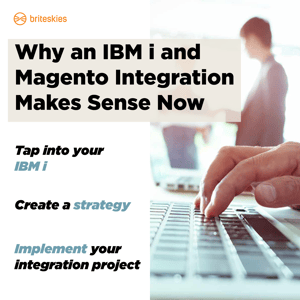Find eCommerce Success with an IBM i and Magento Integration
 Learn how your IBM i can lead your company to a thriving eCommerce site
Learn how your IBM i can lead your company to a thriving eCommerce site
Online retail platforms offer an efficient ordering experience for customers, making it easier for them to place orders quickly and effectively. Ecommerce sites boost the likelihood of repeat business and enhances revenue generation and overall profit margins.
Don't underestimate the power of your current ERP system, the IBM i is perfectly capable of handling the demands of an online retail platform. By following a strategic integration plan, you can streamline processes, increase revenue, and enhance the overall user experience for your customers.
IBM i and eCommerce Integration for Business Success
The IBM i is a great platform for commerce. The IBM i is not only able to, but is designed to deliver on these top e-commerce needs:
- Easily handles complex business logic
- Capable of storing large amounts of data
- Boasts an uptime of over 99.9%
- Faster transaction processing than any other system
The IBM i is a robust and dependable platform with all the essential information required to build a successful eCommerce website. The first step for integrating IBM i with ecommerce sites is defining an integration strategy.
The Best ERP and eCommerce Integration Strategy
An integration project can feel overwhelming, but with the right prep work you can hit the ground running.
Define your eCommerce Strategy by asking the right questions
Start solidifying your eCommerce strategy by answering a few crucial questions.
- Who are you selling to? Are your current customer personas applicable to your eCommerce project? Or do you need to create a new set of personas exclusive to the online channel? Identify who your eCommerce customers are, what they're looking for, and how they want to access product information and ordering.
- How will you use eCommerce within your sales cycle? Why are you implementing eCommerce in the first place? If you're having a hard time answering this, we find most companies have one of the three desires:
- Expand into new channels and markets in order to increase revenue opportunities
- Automate processes in order to lower operating costs
- Improve customer experience in order to improve customer service and attain higher rate of repeat customers
When answering these questions, don't forget to think beyond the current circumstances, instead, consider what you want your company capabilities to look like in a year, five years, and ten years. Those goals should inform your eCommerce strategy.
Why You Should use ERP Data when creating an eCommerce website
An eCommerce site requires a lot of data, most of which is probably stored in your IBM i already. Data organization can be one of the most tedious and time-consuming parts of an integration project. Since most of the data already exists in your ERP, you should use the ERP as a starting point for creating your eCommerce strategy. Data fields that are often used include:
- Extended descriptions
- Product attribution
- Product imagery
This is also a good time to consider which products will be sold online and which won't. Go through your files and remove or archive duplicate items, misnamed products, and out of date information.
Designing Your eCommerce Site
Achieving a successful site takes more information than just your brand colors and an "add to cart" button. Get your team together and start brainstorming a wants and needs list.
Take a look at competitor sites and note what you like and dislike. Identify the look and feel you want your site to have. Do you have any unique features that need to be considered? For example, we've had a client who sells very specific and detailed amounts of cable, or a client whose customer didn't care about the brand or description of an item, just the item itself. Identify these features now, as they will affect site design in the future.
Consider how you'll want categories structured, SKU numbers, accessories, and options for cross-selling and upselling.
I have a few questions…
Struggling with defining your eCommerce strategy? Not sure how to find your product data? Not even sold on eCommerce in the first place? There are lots of moving parts to an IBM i and Magento integration. Download our comprehensive guide for more information on how to get started, what the project will look like, and how it will benefit your company.

